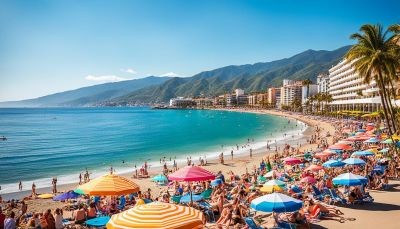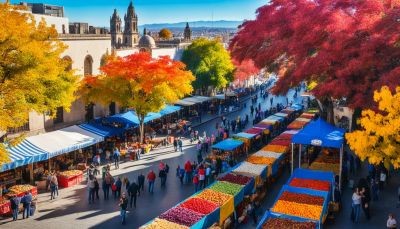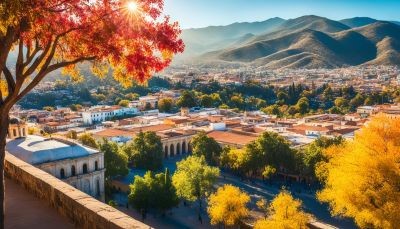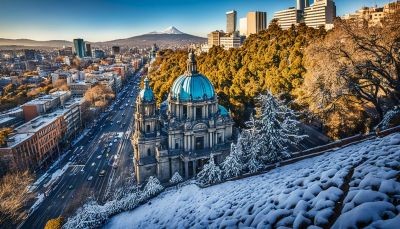Picture yourself walking the spotless beaches of Cancun. The Mexican Caribbean seems to invite you in with its clear water. Feel the gentle, warm breeze on your skin. But, when's the top time to plan your Cancun trip for great weather?
The best window for a visit is from December to March. This period has clear and warm weather. Since it's the peak season, there will be a lot of tourists. Want to skip the crowds or save some cash? Consider a visit during a quieter period.
In summer and fall, Cancun gets humid and rainy. There's also a chance of tropical storms and hurricanes. But, these months are great for those on a budget. You can find amazing flight and stay deals. Spring is nice too, but remember the spring breakers might be around.
Key Takeaways
- The best time to visit Cancun is from December through March for the ideal weather and fewer crowds.
- The summer and fall months can offer better deals, but also have a higher risk of tropical storms and hurricanes.
- Spring break crowds are something to consider if you're looking for a more relaxed vacation.
- Researching the weather patterns and seasonal events can help you plan the perfect Cancun trip.
- Being weather-savvy and flexible with your travel dates can lead to the best experiences in Cancun.
Understanding Cancun's Weather Patterns
Cancun sits on Mexico's Yucatan Peninsula's coast, known for its tropical climate. This climate is heavily influenced by the nearby Gulf of Mexico. Knowing about Cancun Weather, such as Temperatures, Rainfall, Humidity, and Hurricane Season, is key. It helps in planning a trip to this sunny location with the best weather.Hottest Months: June, July, August
The peak of summer, from June to August, marks Cancun's hottest seasons. Temperatures soar to an average of 82°F (28°C). This is when humidity is at its highest, making the weather feel even warmer.Coldest Month: January
On the other hand, January sees the coolest weather in Cancun, with temperatures around 73°F (23°C). It might still feel warm to visitors, but it's cooler compared to the hot summer days.Wettest Month: October
October tops the charts as the Wettest Month in Cancun, with about 10.7 inches of rain. The rainy season is linked to the Atlantic hurricane season. This proximity causes an increase in rainfall.Windiest Month: April
Wind patterns play a role in Cancun's weather, with April as the standout. It’s the Windiest Month, experiencing average wind speeds of 8.6 mph. The winds make beach days more lively and bring a pleasant breeze in the warmth.Warmest Water Temps: August
August boasts the warmest Caribbean Sea water temperatures in Cancun. It reaches about 85°F (29°C). Perfect for those looking to enjoy the beach at its prime during the summer.Understanding Cancun's seasonal Weather and conditions is essential for planning a trip. This knowledge of Temperatures, Rainfall, Humidity, and Hurricane Season will guide you. It ensures your vacation is well-prepared for the best weather possible.
Cancun's High Season
Cancun's high season runs from mid-December to late March. During this time, more people visit. Tourist spots get busier and prices go up, especially around Christmas and Spring Break.Ideal Beach Weather
The weather in Cancun during the high season is perfect for the beach. Expect sunny days with temperatures from 75°F to 90°F. This makes it a great time to enjoy the Mexican Caribbean's beautiful waters and beaches.Potential for Occasional Cold Fronts
Even though it's mostly warm, Cancun's weather can change. Cold fronts sometimes bring cooler days. If you'll be there during the busy holiday crowds or for Spring Break, it's good to bring a light sweater or jacket.Cancun's Low Season
Cancun's high season runs from December to April with sunny skies and warm days. But, from June to October, it's the Cancun Low Season. This time brings hot, humid days with frequent showers. It's Mexico's rainy season.Rainy Season: June to October
In the Cancun Rainy Season, expect hot and sticky weather. Showers and thunderstorms happen often. The rain is not constant, usually coming in bursts.You'll also see the sun between rains. This means beach time might be limited. However, there's still lots to do and see in Cancun.
Fewer Crowds and Lower Prices
Choosing Cancun's low season means thinner crowds. Many tourists stay away due to the hurricane season and rainy days. You'll enjoy quiet beaches, shorter lines, and better costs on hotels and flights.Sargasso Seaweed Concerns
Sargasso seaweed is more common in Cancun's low season. This brown algae can sometimes spoil the water for swimming. Always check conditions if you plan to hit the beach.Cancun's Shoulder Season
If you want to enjoy Cancun with fewer people and great weather, visit during the shoulder season. This time runs from April to early December. During this season, you will find fewer crowds and good prices.It is a little more expensive than the low season. However, it's a chance to see Cancun in its tropical beauty. You won't have to worry about rain or huge crowds. Accommodations are available, but booking early is still wise. Plus, flights are often cheaper.
The weather during Cancun's shoulder season is perfect. It has mild temperatures and less rain. This is the best time to visit Cancun if you love beaches and outdoor fun. It's better than the hot, sticky summers or the stormy low season.
Spring in Cancun
As the winter chill starts to fade, Cancun becomes a lively spring spot. It pairs mild weather with little rain. This makes it perfect for enjoying nature and local life.Mild Temperatures and Minimal Rainfall
Spring in Cancun means lovely weather. Temps stay between a comfy 75°F and a warm 85°F. It's drier than summer and fall. So, it's great for beach days, exploring, and outdoor fun.Spring Break Crowds
Spring in Cancun is also Spring Break season. From mid-March to April, lots of college kids visit. They come for the sun, sand, and fun. If you prefer quieter trips, visit outside of Spring Break time to skip the big crowds and parties.Chichen Itza Equinox Experience
The highlight of spring in Cancun is seeing Chichen Itza on the spring equinox. This happens on March 20 or 21. At this time, you can see Kukulcan, the feathered snake god, seeming to descend El Castillo Pyramid's steps. It's a rare and amazing sight.Summer in Cancun
As summer arrives, Cancun becomes a prime destination. The weather is usually hot and humid, with afternoon showers common. Despite the rain, there are still many activities to do both inside and outside in this lively city.Hot and Humid Weather
In summer, temperatures in Cancun soar, often reaching 90°F (32°C). The air is also very humid, which can make it feel hotter. It's vital to drink plenty of water, find shade, and avoid too much sun exposure.Rainy Days and Potential Hurricanes
The summer ushers in more rain, with hurricane season from June to November. The downpours are usually brief but heavy and can disrupt outdoor plans. It's wise for visitors to stay up to date on the weather and adjust their schedules if necessary.Whale Shark Watching Season
Summer is the ideal time to see Whale Sharks near Cancun. These huge, but harmless, sea creatures migrate from mid-May to September. This period is popular among those interested in eco-tourism and nature.Fall in Cancun
As summer winds down, Cancun's fall season steps in with mild weather and less rain. This time of year in the Mexican Caribbean is great for those wanting to avoid the big tourist crowds. It's perfect for diving into local culture and traditions.Moderate Temperatures and Rainfall
In fall, Cancun has lovely weather, with temperatures in the 70s to 80s. There are still showers from summer, but they're short. This means sunny breaks happen often, making it a great time to enjoy outdoor activities.Cultural Festivals and Events
Autumn in Cancun is full of cultural festivals and events. September sees Mexican Independence Day with music and food. Then, in October, there's the Day of the Dead, a rich celebration of life with vibrant altars and parades.The Riviera Maya Jazz Festival lights up November in Playa del Carmen. It's a chance to hear top jazz artists for free among Mexico's lively music scene.
Cancun, Quintana Roo: Best Months for a Weather-Savvy Trip
The best time to visit Cancun is from December through April. This period has the best weather. Days are sunny, warm, and perfect for the beach. It is during this time that crowds are highest and prices are more expensive.Optimal Travel Period: December to April
Want to enjoy Cancun without intense crowds? Try going in the shoulder season months. These months are April, May, November, and early December. You'll still get nice weather, but with fewer people around.Planning Your Cancun Vacation
When getting ready for Cancun, think about what you need to bring. You'll want to pack light clothes for the hot weather, like shorts and tank tops. Also, include a light sweater for air-conditioned places.Don't forget to pack sunscreen and bug spray to stay safe and comfortable.
Hurricane Season Considerations
If your trip is during hurricane season (from June to November), it's important to be ready. Keep an eye on the weather and be ready to change your plans if needed.Know what to do if there's an emergency at your resort. It's also good to have a backup place to stay in mind.
Travel Insurance Recommendations
For a worry-free Cancun trip, consider getting good travel insurance. It can cover things like flight issues, health emergencies, and trip cancellations. This way, you can enjoy your trip without stress, knowing you're covered.FAQ
What is the best time to visit Cancun?
The best time to visit Cancun is from December to March. The weather is warm and clear, perfect for a beach vacation. It's high season, so there will be many other visitors enjoying the beautiful weather. For fewer crowds and better deals, consider another time of year.
What are the hottest, coldest, wettest, and windiest months in Cancun?
The hottest months in Cancun are June, July, and August. Average temperatures are around 82°F. The coldest month is January, with temperatures around 73°F. October is the wettest, with an average rainfall of 10.7 inches. April is the windiest, with an average speed of 8.6 mph.
What is Cancun's high season and what is it like?
Cancun's high season goes from mid-December to late March. December has holiday crowds, while March has lively spring breakers. The weather is perfect for the beach, with sunny days and temperatures between 75°F and 90°F. Prices soar during this time.
What is Cancun's low season like?
Cancun's low season is from June to October, the rainy season. It's hot, humid, and rainy, but the sun still shines between showers. Beaches are less crowded, and prices are lower. Yet, there may be a lot of seaweed in the sea.
When is the shoulder season in Cancun and what is it like?
The shoulder season in Cancun is in April, May, November, and early December. It's less busy and the weather is still good, making it ideal for those who want to avoid rain. Rates are more reasonable than the high season.
What is spring like in Cancun?
Spring in Cancun offers good weather with mild temperatures and less rain. But it's a popular time, especially from mid-March to April, due to spring breakers. A highlight is visiting Chichen Itza on the spring equinox.
What is summer like in Cancun?
Summers in Cancun are hot, humid, and prone to rain. Yet, it's a good season to see whale sharks. You can also find nice deals on flights and hotels. Be aware of the possibility of tropical storms and hurricanes.
What is fall like in Cancun?
Fall in Cancun means pleasant weather and moderate rainfall. However, there's still a risk of storms and hurricanes until November. This season brings cultural celebrations, like Mexican Independence Day and Day of the Dead.
What is the best time to visit Cancun overall?
The best overall time to visit Cancun is from December to early April. The weather is perfect for the beach. For fewer crowds, consider the shoulder season in April, May, or November. There's still plenty of good weather without the high season rush.
What should I pack for a Cancun vacation?
For your Cancun trip, pack light and cool clothes like shorts and tank tops. Don't forget your beachwear. Bring a sweater for indoor places. Pack sunscreen and bug repellent. If traveling during hurricane season, keep an eye on the weather and get travel insurance.











